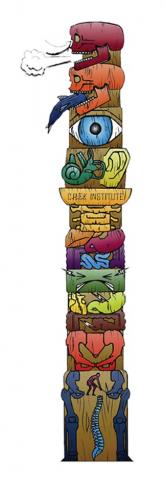Lifting, throwing, punching, wrestling, pulling, paddling, swimming and pressing with troubled shoulders is a common problem these days. There’s too many causes to list here, but to throw out a few examples we’ve got most people walking around with hunched upper backs, heads that droop forward, chests that slump, high hips, rotated hips and too much general stress dumping into their nervous systems. The specific reasons for the shoulder issue is individual and the first concern would be to get an assessment by a qualified rehab professional. If you go for a generalised approach and dive straight into the shoulder (symptom), you might be missing the true cause of the issue which could be anything from a “stuck” hip, or an ankle range-of-motion deficit, to a breathing limitation which drives the head forward.
The Shoulder
The shoulder is inherently unstable. The human shoulder is made up of three bones: the clavicle (collarbone), the scapula (shoulder blade), and the humerus (upper arm bone) as well as associated muscles, ligaments and tendons. The glenoid (shoulder socket) only contacts approx 30% of humeral (upper arm bone) head. The labrum (cartilage ring) increases joint surface and stability is reinforced by ligaments and tendons. The compromise between mobility and stability results in a large number of shoulder problems not faced by other joints such as the hip which is inherently more stable.
Common Problem Areas
There is a negative pressure in a healthy shoulder joint, which acts like a vacuum and keeps the humeral head glued firmly to the glenoid fossa in a healthy way during movement. Shoulder surgery can take away this negative pressure, making the joint less stable.
Shoulder injury = neck injury = jaw injury. Assess vision, hearing and bite before you look at the neck. The neck affects shoulder. Check for forward head posture. Many survival functions and reflex mechanisms reign superior to the shoulder. Paul Chek displays this idea brilliantly with his Totem Pole of importance: 1. Respiration, 2. Mastication, 3. Vision, 4. Balance/Hearing/Vestibular, 5. Atlas, 6. Digestion, 7. Emotions, 8. Reproductive, 9. Slave joints below the atlas (including shoulder). Order of importance is not necessarily numbered in this order with all cases.

Any trigger point in the body can cause muscle fibres to recruit in a non-synchronistic way, so they all turn on at once and tense up.
Anything disrupting the lower body is mirrored in the upper body. For example, a right shoulder dysfunction mirrors a left hip dysfunction in most cases. When we walk we counter rotate. Cervical and lumbar spine tend to move together, and the thoracic goes the opposite way.
Poor thoracic spine mobility and rounded curvatures. If you cannot extend your thoracic spine to neutral and beyond, do not flex the shoulder greater 140deg, meaning no overhead lifting until mobility is restored. An injured shoulder follows a screwed up thoracic spine, just as an injured shoulder follows a screwed up cervical spine.
Tingling or numbness in the little and/or ring finger = symptom of brachial plexus compression. Often arise when the lower cord of the brachial plexus is being abnormally stretched or compressed. Excessive tightness in the pec minor can cause this, as can a depressed chest, amongst others.
The anterior capsule is weakest portion of capsule relative to the forces passing thru the tissue. The anterior capsule is stressed with abduction plus external rotation and with arm extension.
Take care with these exercises if you are currently experiencing shoulder issues
Reverse Grip Bent Over Row
This exercise can turn out to be very guilty. The humeral head moves fwd under load which is not a place from which you wish to be loading the shoulder. Reverse grips fires the biceps also. It is possible to develop a slap lesion (superior labral anterior to posterior), or front to side tear of labrum, where the bicep comes off and pulls the labrum with it.
Tricep Dip
With tricep dips, the humeral head shears fwd with arm extension which places excessive tension on the supraspinatus (a rotator cuff) muscle. If you must do this exercise, don’t let the elbow bend greater than 90deg unless assessed. Always stop before end ROM to give u a buffer zone when u fatigue. You can also adjust your technique by allowing the upper body to bend forward, which reduces pressure in joint.
Lat-pull-down behind the head
Fear of hitting head causes faulty form – forward head posture and a collapsed chest..not a strong position! Instead, pull the bar in front of the head to the upper chest. If you pull down too far and forward, the subscapularis is overly stressed and can tear.
Bench Press
Often leading to an overstretched anterior capsule. Limit range of motion and quit if you get pain at the front of the shoulder. Test shoulder joint integrity (end-range) before doing exercise, especially bench press. Most men have overstretched anterior capsule from overdoing the bench press and reverse fly. Need to use a ROM limiter, eg. Rolled up towel or block on the chest and perform floor pressing. Training beyond the shoulder’s passive ROM barrier with heavy loads stretches the anterior shoulder joint capsule – which means you can no longer stabilise during common movements like swimming, throwing, catching.
And finally,
Any upper body loading with a forward head posture
Forward head posture = compromised root structures at the C4/5, C5/6 and C6/7 spinal levels. The rotator cuff receives primary innervations from these nerve roots, so any compromise may lead to inhibition of the relevant rotator cuff muscles. If conduction thru the nerves is inhibited, the supraspinatus, infraspinatus, rhomboid and levator scapula will not respond to conditioning stimuli, meaning your shoulder will not be optimally protected from injury during lifting.
If you’ve got funked up shoulders, your first priority will be to balance the shoulder joint first, gaining stability, offloading stress in overworked muscles, ironing out trigger points, stretching tight muscles, regaining healthy range-of-motion and taking a break from movements that are causing you pain. Get healthy shoulders with my online strength and conditioning coaching.
Read Shoulder Problems in Sport and Exercise Part 2 for example exercises that you can try today.
